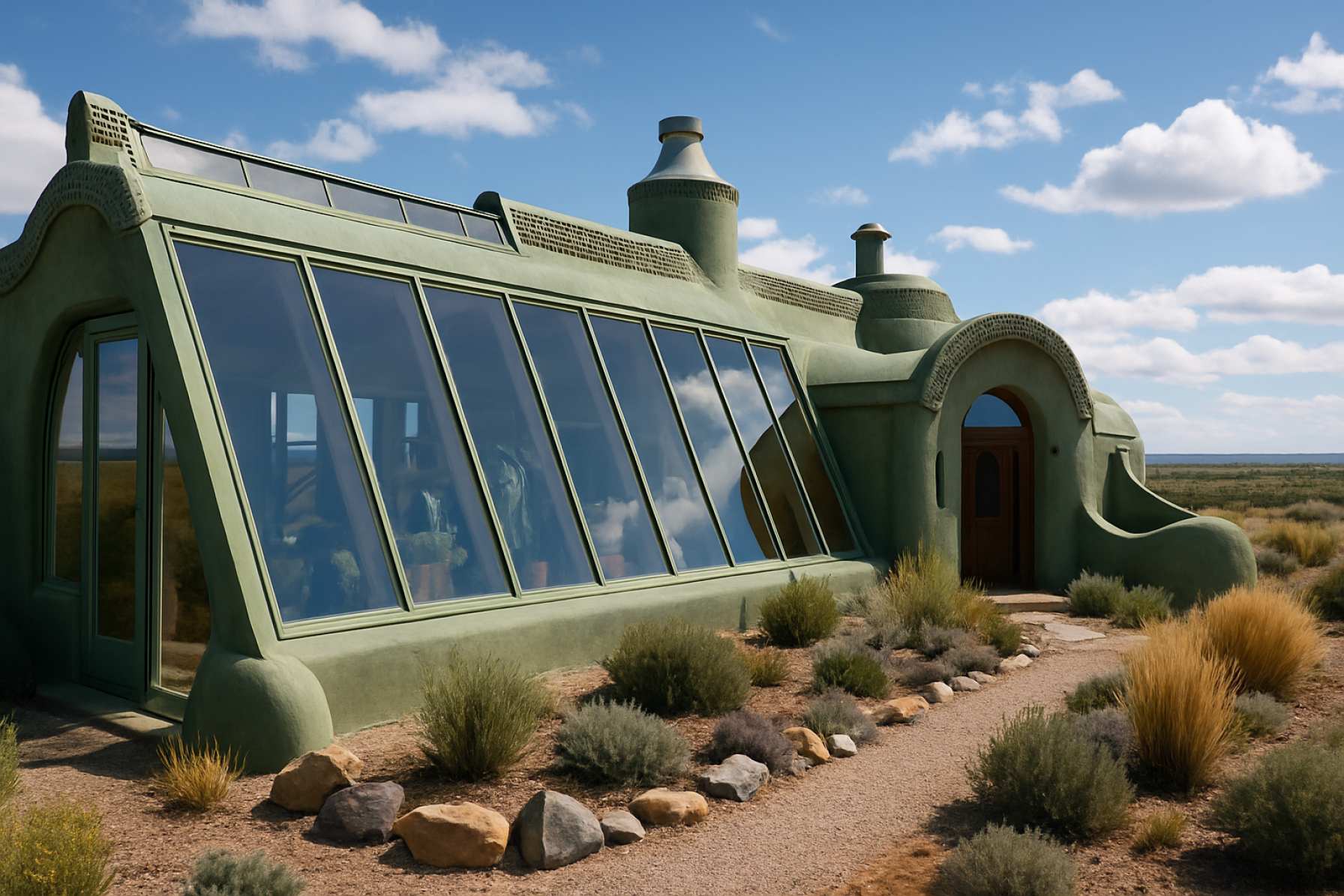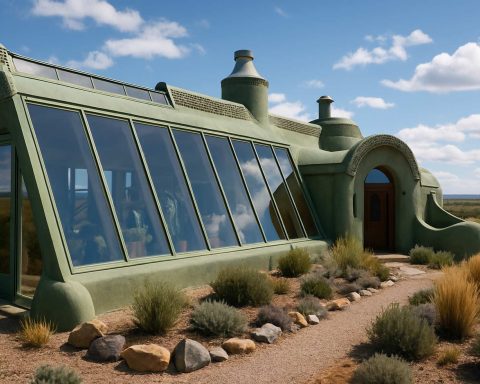Discover the Power of Earthship Architecture: How Off-Grid Homes Are Redefining Eco-Friendly Living for a Resilient Future
- Introduction to Earthship Architecture
- Core Principles and Design Philosophy
- Materials and Construction Techniques
- Energy Efficiency and Off-Grid Systems
- Water Harvesting and Waste Management
- Thermal Comfort and Passive Solar Design
- Case Studies: Successful Earthship Projects
- Challenges and Criticisms
- Future Trends and Global Impact
- Sources & References
Introduction to Earthship Architecture
Earthship architecture is a form of sustainable building design that emphasizes self-sufficiency, ecological responsibility, and the use of natural and recycled materials. Developed in the 1970s by architect Michael Reynolds, Earthships are designed to function as autonomous structures, minimizing reliance on external utilities and resources. These buildings typically incorporate passive solar heating and cooling, rainwater harvesting, on-site wastewater treatment, and renewable energy systems such as solar panels and wind turbines. The walls are often constructed from earth-filled tires, glass bottles, and aluminum cans, which provide both insulation and structural integrity while diverting waste from landfills.
A key principle of Earthship architecture is the integration of building and environment, allowing the structure to respond to local climate conditions and resource availability. The design often features south-facing windows for optimal solar gain, thermal mass walls to regulate indoor temperatures, and indoor greenhouses for food production and air purification. This holistic approach aims to create dwellings that are not only environmentally friendly but also resilient and cost-effective over the long term.
Earthship communities have been established in various climates worldwide, demonstrating the adaptability of the concept. While originally conceived as off-grid homes, Earthship principles are increasingly being applied to public buildings and disaster relief housing. The movement has inspired a global network of practitioners and advocates, with educational programs and demonstration projects available through organizations such as the Earthship Biotecture and resources from the United Nations Environment Programme. As concerns about climate change and resource scarcity grow, Earthship architecture offers a compelling model for sustainable living in the 21st century.
Core Principles and Design Philosophy
Earthship architecture is guided by a set of core principles and a design philosophy that seeks to create self-sufficient, sustainable dwellings with minimal environmental impact. At its heart, Earthship design emphasizes the use of natural and recycled materials—such as earth-packed tires, bottles, and cans—to construct thermally efficient structures. This approach not only diverts waste from landfills but also leverages the thermal mass of these materials to regulate indoor temperatures, reducing or eliminating the need for conventional heating and cooling systems (Earthship Biotecture).
A fundamental principle is the integration of passive solar design. Earthships are typically oriented to maximize solar gain in winter and minimize it in summer, using south-facing windows (in the Northern Hemisphere) and strategic shading. This passive approach is complemented by systems for rainwater harvesting, water recycling, and on-site sewage treatment, allowing the building to operate independently of municipal utilities (ArchDaily).
Another key aspect is the promotion of food production within the home. Many Earthships incorporate indoor or attached greenhouses, enabling residents to grow food year-round. The design philosophy extends beyond technical solutions, advocating for a lifestyle that is resilient, resource-conscious, and in harmony with local ecosystems. This holistic approach positions Earthship architecture as both a response to environmental challenges and a model for regenerative living (United Nations Environment Programme).
Materials and Construction Techniques
Earthship architecture is distinguished by its innovative use of recycled and natural materials, combined with construction techniques that prioritize sustainability and self-sufficiency. The primary structural element in most Earthships is the earth-rammed tire wall. Discarded automobile tires are packed tightly with compacted earth, then stacked in an interlocking pattern to form thick, load-bearing walls. These walls provide exceptional thermal mass, regulating indoor temperatures by absorbing and slowly releasing heat, which reduces the need for conventional heating and cooling systems (Earthship Biotecture).
In addition to tires, Earthship builders commonly incorporate other recycled materials such as aluminum cans and glass bottles. These are often used to create non-load-bearing interior walls, where cans and bottles are mortared together in decorative patterns, further reducing the demand for new building materials. The use of adobe, cob, and locally sourced earth is also prevalent, especially for plastering and finishing surfaces, enhancing both insulation and aesthetic appeal (ArchDaily).
Construction techniques emphasize passive solar design, with south-facing glass walls (in the Northern Hemisphere) to maximize solar gain. Roofs are typically constructed with recycled steel or wood, and are designed to harvest rainwater. The integration of these materials and methods results in buildings that are not only environmentally responsible but also resilient and adaptable to a variety of climates (Green Building Advisor).
Energy Efficiency and Off-Grid Systems
A defining feature of Earthship architecture is its commitment to energy efficiency and the integration of off-grid systems. Earthships are designed to operate independently from conventional utilities, relying on passive solar heating and cooling, renewable energy sources, and innovative water management. The buildings are typically oriented to maximize solar gain, with large south-facing windows and thick, earth-rammed tire walls that provide substantial thermal mass. This design allows Earthships to maintain comfortable indoor temperatures year-round with minimal reliance on external energy sources, even in extreme climates (National Renewable Energy Laboratory).
Photovoltaic panels and wind turbines are commonly used to generate electricity, which is stored in battery banks for use during periods of low sunlight or wind. Energy-efficient appliances and LED lighting further reduce overall consumption. Water harvesting systems collect rainwater from the roof, which is then filtered and reused multiple times for drinking, washing, and irrigation. Greywater and blackwater are treated on-site through botanical cells and contained wetlands, minimizing waste and environmental impact (U.S. Environmental Protection Agency).
These integrated systems enable Earthships to function autonomously, making them particularly attractive for remote locations or areas with unreliable infrastructure. The holistic approach to energy and resource management not only reduces the ecological footprint of the building but also empowers occupants to live sustainably and resiliently in the face of environmental and economic uncertainties (United Nations Environment Programme).
Water Harvesting and Waste Management
A cornerstone of Earthship architecture is its innovative approach to water harvesting and waste management, designed to maximize self-sufficiency and minimize environmental impact. Earthships typically collect rainwater from their roofs, channeling it through a filtration system into cisterns for household use. This harvested water is used sequentially: first for drinking and bathing, then for irrigating indoor botanical cells, and finally for flushing toilets. This cascading use of water exemplifies the Earthship principle of maximizing resource efficiency and reducing reliance on municipal water supplies (Earthship Biotecture).
Wastewater management in Earthships is equally innovative. Greywater—wastewater from sinks, showers, and washing machines—is filtered through indoor planters, where plants absorb nutrients and further purify the water. This treated greywater is then reused for toilet flushing. Blackwater, or sewage from toilets, is processed in contained septic systems or constructed wetlands, where natural biological processes break down waste. These systems are designed to prevent contamination of groundwater and to recycle nutrients back into the environment (U.S. Environmental Protection Agency).
By integrating water harvesting and closed-loop waste management, Earthship architecture not only reduces environmental pollution but also empowers inhabitants to live off-grid, even in arid or remote locations. These systems demonstrate a practical model for sustainable living, aligning with broader goals of water conservation and ecological stewardship (United Nations Environment Programme).
Thermal Comfort and Passive Solar Design
A cornerstone of Earthship architecture is its commitment to thermal comfort through passive solar design. Earthships are strategically oriented—typically with their glazed façade facing true south in the Northern Hemisphere—to maximize solar gain during winter months and minimize it during summer. The building envelope is constructed with thick, earth-rammed tire walls, which serve as high-mass thermal batteries. These walls absorb heat from sunlight during the day and slowly release it at night, stabilizing indoor temperatures and reducing reliance on mechanical heating or cooling systems. This approach is known as thermal mass, and it is critical for maintaining a comfortable living environment in varying climates.
The use of earth berming—where the structure is partially buried in the ground—further enhances insulation and temperature regulation. The earth acts as a natural insulator, keeping interiors cool in summer and warm in winter. Additionally, Earthships incorporate operable vent boxes and skylights to facilitate natural ventilation and convective cooling, allowing hot air to escape and fresh air to circulate without the need for air conditioning. The combination of these passive solar and thermal mass strategies enables Earthships to achieve remarkable energy efficiency and occupant comfort, even in extreme climates. For more detailed information on these principles, see Earthship Biotecture and U.S. Department of Energy.
Case Studies: Successful Earthship Projects
Several Earthship projects worldwide exemplify the adaptability and success of this sustainable architectural approach. One of the most prominent examples is the Earthship Biotecture Headquarters in Taos, New Mexico. This site serves as both a demonstration and research center, showcasing various Earthship models that have been refined over decades. The headquarters not only houses residents but also hosts educational workshops, proving the viability of Earthships in arid, high-desert climates.
Another notable project is the Earthship Brighton in the United Kingdom. Built by the Low Carbon Trust, this Earthship adapts the original design to the cooler, wetter climate of southern England. It functions as a community center and educational facility, demonstrating how Earthship principles can be modified for different environmental conditions and regulatory frameworks.
In Canada, the Earthship Canada project in Alberta highlights the adaptability of Earthship architecture to cold climates. The building incorporates additional insulation and passive solar design to maintain comfortable indoor temperatures year-round, despite harsh winters.
These case studies illustrate that Earthship architecture is not limited to one region or climate. By adapting to local materials, regulations, and environmental challenges, Earthship projects have successfully demonstrated the potential for self-sufficient, low-impact living across diverse settings. Their continued operation and community engagement underscore the practical and educational value of Earthship design worldwide.
Challenges and Criticisms
Despite its innovative approach to sustainable living, Earthship architecture faces several challenges and criticisms that limit its mainstream adoption. One of the primary concerns is compliance with local building codes and regulations. Many municipalities have strict codes that do not accommodate the unconventional materials and construction methods used in Earthships, such as rammed earth tires and greywater systems. This often results in lengthy approval processes or outright rejection of Earthship projects by local authorities (International Code Council).
Another significant challenge is the climate adaptability of Earthships. While the design is highly effective in arid or temperate regions, it can be less suitable in humid or extremely cold climates. Issues such as condensation, mold, and insufficient passive heating or cooling have been reported in non-ideal environments, requiring costly modifications or supplemental systems (U.S. Department of Energy).
Critics also point to the labor-intensive nature of Earthship construction. Building with recycled materials like tires and bottles is time-consuming and physically demanding, often necessitating skilled labor or extensive volunteer involvement. Additionally, the availability and transportation of suitable recycled materials can be problematic in some regions (U.S. Environmental Protection Agency).
Finally, some environmentalists question the long-term sustainability of using tires, which can off-gas volatile organic compounds, and the overall scalability of Earthship principles for urban or high-density settings. These factors contribute to ongoing debates about the practicality and environmental impact of Earthship architecture in diverse contexts (Royal Institute of British Architects).
Future Trends and Global Impact
Earthship architecture, originally developed by Michael Reynolds in the 1970s, is increasingly recognized as a pioneering model for sustainable building worldwide. As climate change intensifies and resource scarcity becomes more pressing, the principles of Earthship design—such as passive solar heating, water harvesting, and the use of recycled materials—are gaining traction in both developed and developing regions. The future of Earthship architecture is marked by its adaptability to diverse climates and its potential to address housing shortages while minimizing environmental impact.
Globally, Earthship projects are expanding beyond their origins in the American Southwest. Countries such as the United Kingdom, France, and India have seen the construction of Earthship-inspired buildings, often adapted to local regulations and materials. This international spread is facilitated by growing networks of practitioners and organizations, such as Earthship Biotecture, which provide training and resources for communities worldwide.
Looking ahead, future trends in Earthship architecture include the integration of smart technologies for energy management, the use of advanced water filtration systems, and the development of modular designs for rapid deployment in disaster relief and affordable housing initiatives. Additionally, there is a growing emphasis on policy advocacy to incorporate Earthship principles into mainstream building codes, as seen in pilot projects and collaborations with governmental bodies (United Nations Environment Programme).
The global impact of Earthship architecture lies in its demonstration that self-sufficient, low-impact housing is not only feasible but scalable. As urbanization accelerates and environmental concerns mount, Earthship principles are poised to influence the future of sustainable construction worldwide.
Sources & References
- United Nations Environment Programme
- ArchDaily
- National Renewable Energy Laboratory
- International Code Council











